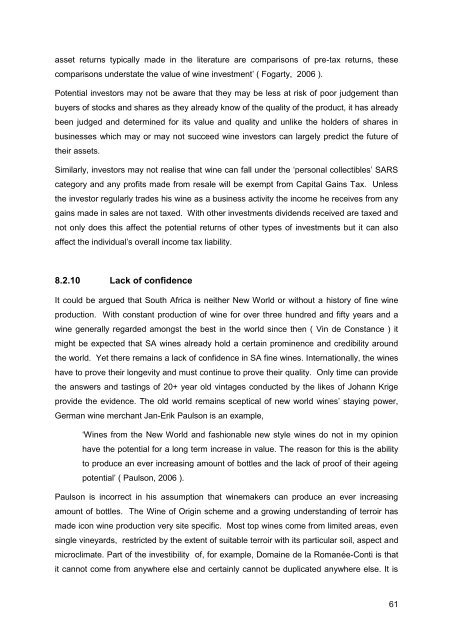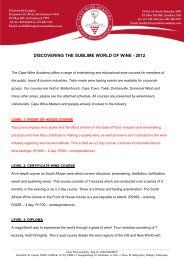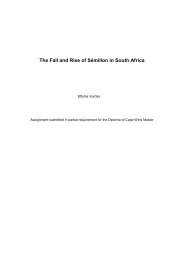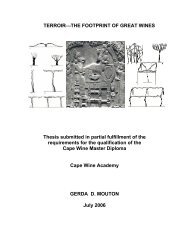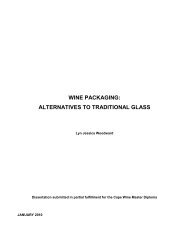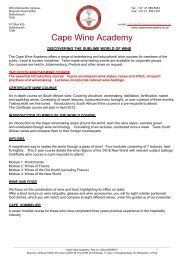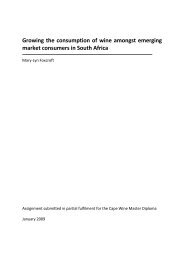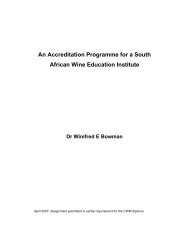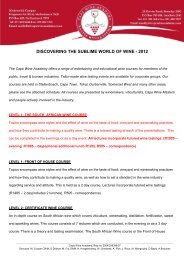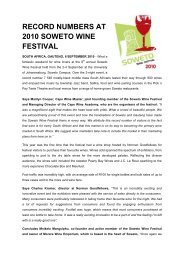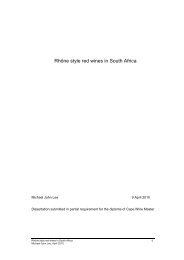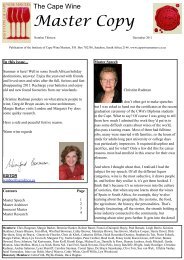Wine Investment in South Africa - Cape Wine Academy
Wine Investment in South Africa - Cape Wine Academy
Wine Investment in South Africa - Cape Wine Academy
You also want an ePaper? Increase the reach of your titles
YUMPU automatically turns print PDFs into web optimized ePapers that Google loves.
asset returns typically made <strong>in</strong> the literature are comparisons of pre-tax returns, these<br />
comparisons understate the value of w<strong>in</strong>e <strong>in</strong>vestment’ ( Fogarty, 2006 ).<br />
Potential <strong>in</strong>vestors may not be aware that they may be less at risk of poor judgement than<br />
buyers of stocks and shares as they already know of the quality of the product, it has already<br />
been judged and determ<strong>in</strong>ed for its value and quality and unlike the holders of shares <strong>in</strong><br />
bus<strong>in</strong>esses which may or may not succeed w<strong>in</strong>e <strong>in</strong>vestors can largely predict the future of<br />
their assets.<br />
Similarly, <strong>in</strong>vestors may not realise that w<strong>in</strong>e can fall under the ‘personal collectibles’ SARS<br />
category and any profits made from resale will be exempt from Capital Ga<strong>in</strong>s Tax. Unless<br />
the <strong>in</strong>vestor regularly trades his w<strong>in</strong>e as a bus<strong>in</strong>ess activity the <strong>in</strong>come he receives from any<br />
ga<strong>in</strong>s made <strong>in</strong> sales are not taxed. With other <strong>in</strong>vestments dividends received are taxed and<br />
not only does this affect the potential returns of other types of <strong>in</strong>vestments but it can also<br />
affect the <strong>in</strong>dividual’s overall <strong>in</strong>come tax liability.<br />
8.2.10 Lack of confidence<br />
It could be argued that <strong>South</strong> <strong>Africa</strong> is neither New World or without a history of f<strong>in</strong>e w<strong>in</strong>e<br />
production. With constant production of w<strong>in</strong>e for over three hundred and fifty years and a<br />
w<strong>in</strong>e generally regarded amongst the best <strong>in</strong> the world s<strong>in</strong>ce then ( V<strong>in</strong> de Constance ) it<br />
might be expected that SA w<strong>in</strong>es already hold a certa<strong>in</strong> prom<strong>in</strong>ence and credibility around<br />
the world. Yet there rema<strong>in</strong>s a lack of confidence <strong>in</strong> SA f<strong>in</strong>e w<strong>in</strong>es. Internationally, the w<strong>in</strong>es<br />
have to prove their longevity and must cont<strong>in</strong>ue to prove their quality. Only time can provide<br />
the answers and tast<strong>in</strong>gs of 20+ year old v<strong>in</strong>tages conducted by the likes of Johann Krige<br />
provide the evidence. The old world rema<strong>in</strong>s sceptical of new world w<strong>in</strong>es’ stay<strong>in</strong>g power,<br />
German w<strong>in</strong>e merchant Jan-Erik Paulson is an example,<br />
‘<strong>W<strong>in</strong>e</strong>s from the New World and fashionable new style w<strong>in</strong>es do not <strong>in</strong> my op<strong>in</strong>ion<br />
have the potential for a long term <strong>in</strong>crease <strong>in</strong> value. The reason for this is the ability<br />
to produce an ever <strong>in</strong>creas<strong>in</strong>g amount of bottles and the lack of proof of their age<strong>in</strong>g<br />
potential’ ( Paulson, 2006 ).<br />
Paulson is <strong>in</strong>correct <strong>in</strong> his assumption that w<strong>in</strong>emakers can produce an ever <strong>in</strong>creas<strong>in</strong>g<br />
amount of bottles. The <strong>W<strong>in</strong>e</strong> of Orig<strong>in</strong> scheme and a grow<strong>in</strong>g understand<strong>in</strong>g of terroir has<br />
made icon w<strong>in</strong>e production very site specific. Most top w<strong>in</strong>es come from limited areas, even<br />
s<strong>in</strong>gle v<strong>in</strong>eyards, restricted by the extent of suitable terroir with its particular soil, aspect and<br />
microclimate. Part of the <strong>in</strong>vestibility of, for example, Doma<strong>in</strong>e de la Romanée-Conti is that<br />
it cannot come from anywhere else and certa<strong>in</strong>ly cannot be duplicated anywhere else. It is<br />
61


